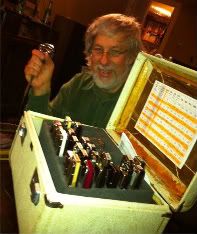TBird
7 posts
Feb 16, 2013
8:38 AM

|
Hi! I am a relatively new player. I certainly have plenty more to discover from the 6 hole down, but I have recently started working on blow bends. Holes 8 and 9 came pretty quickly and I am now hitting those bends with a fair degree of confidence and accuracy. It's the ten hole that is killing me. I get that it should logical be the most difficult to bend, but it seemed WAY harder to learn then the 8 or 9. Is that normal?
I've fiddled with the reeds a little bit and am now starting to get it to bend decently on a somewhat consistent basis. Now, however, it sometimes seems harder to produce clean, strong, unbent 10 hole blow then a bent blow note. I would guess that might mean the blow read is gaped a little to tight. Does that sound right? I'm only confident with doing reed adjustment on the lower holes so I don't want to do to much more with it until I have a little more info.
Of course... the whole thing could just be a matter of poor technique, in which case, feel free to tell me to just shut up and keep practicing!
Thanks,
Tom
|
arzajac
985 posts
Feb 16, 2013
8:57 AM

|
Don't rule out technique.
That being said, what brand of harp is it and what key? Those high holes are very sensitive to airleaks and some harps are more leaky than others.
Try taking off the coverplates and covering the four hole slots, top and bottom with your fingers. I'm assuming the four hole is working fine for you... Make sure the slots are completely sealed and then put the harp to your mouth and "kiss". Try pumping air in and out of the chamber and let your mouth feel how airtight it is. Then do the same with the ten hole. Does the ten hole hold the pressure as well as the four? If it leaks, you will need to find a way to correct the leak and that depends on the brand of harp.
Another adjustment you can make, other than gaps is to look at the reed and push it through the slot. Does any part of it enter the slot first? If there are any "dips", you can correct them. For example, if the tip of the reed is curved in and enters the slot before the rest of the reed, I guarantee the note won't play well. The same if the middle of the reed is "scooped" and enters the slot before either end of the reed.
You will need to take the reedplates off the comb to assess the reeds and to make corrections. Use a toothpick and apply gentle pressure to massage the reed back into shape using your finger on the opposite side to support.
I hope this helps.
----------

Last Edited by arzajac on Feb 16, 2013 8:58 AM
|
timeistight
1120 posts
Feb 16, 2013
9:09 AM

|
Ten-hole bends require very fine embouchure control. Not only is the 10 blow the highest note, it also has twice the bending range of the 8 and 9 bends, making it even more difficult to control.
What key of harp is it? Lower keys require a bit less precision than higher keys, not to mention being easier on the ears.
One tip I got from a Dave Barret video: if the note cracks -- goes from unbent to fully bent with nothing in between -- you're approaching the bend from the wrong direction. That means that your embouchure is to large and is resonating below the bending range of the reed. You need to have your embouchure resonate at the unbent pitch of the note and then minutely lower it into the bend. I think that will help your unbent note production as well.
----------
Playing music... it's a privilege.
Kim Wilson
|
TBird
8 posts
Feb 16, 2013
9:26 AM

|
It's a Marine Band in the key of A (the only harp I have lower then C). Sorry. I meant to include that in the original post.
Very helpful tips so far. Thank you both! I think that idea from Barret seems to address the problems I am having. Very interesting. I'll have to put that to the test.
|
bonedog569
830 posts
Feb 16, 2013
4:23 PM

|
I am starting to use the ten blow bend as the first note in descending licks. Def easier on some harps than others. The blow bends on 8&9 a always come easier and are easier to control. I'll have to ponder on timestight/ Barret advice. Bending from the wrong direction eh?
----------

|
SuperBee
917 posts
Feb 16, 2013
5:20 PM

|
i think i get the notion of wrong direction...im not much of a blow bender i'm afraid but despite my unfocussed practice i have managed to improve. still not quite good enough to incorporate into performance but not far away. i practice the whole step 10 blow bend (+10'') with tequila...maybe i shouldn't drink but it helps dull the pain of those sh1tty notes...
i think i should be hitting the +10'' dead-on, but i usually find i'm sharp and have to bend down. it sounds ok that way but its not my ideal. i think the "wrong direction" refers to hitting it flat and having to let it up a little.
or maybe not...
----------

|
timeistight
1122 posts
Feb 16, 2013
6:21 PM

|
No, that's not what I meant. Let me try again.
All bending involves tuning the resonance of your mouth so that it interacts with the resonances of the reeds in a hole. If your mouth resonance is below the resonance of either reed in the hole, you won't get a bend but if you raise the resonance of your mouth into range, you get that sudden shift from no bend to full bend. That's what I'm calling bending from "the wrong direction," because you have very little control over the bend.
If, on the other hand, you tune your mouth to the resonance of the blow reed and then lower your mouth resonance, you can get a much more controllable bend.
Capiche?
----------
Playing music... it's a privilege.
Kim Wilson
Last Edited by timeistight on Feb 16, 2013 6:31 PM
|
SuperBee
918 posts
Feb 16, 2013
7:52 PM

|
I understand all of that, except for that last word.
----------

|
SuperBee
920 posts
Feb 16, 2013
11:14 PM

|
That's my version of humour...
----------

|
Steamrollin Stan
712 posts
Feb 17, 2013
2:30 AM

|
As a new player i think just hang around the easy holes, the 10 is a bugger to grab unless your gifted.
|
The Iceman
740 posts
Feb 17, 2013
6:47 AM

|
Pretend that the tip of your tongue is super glued to where your front bottom teeth and gums meet.
Now, if you move your tongue forward, it will "lump up" towards the roof of your mouth.
This is the basic set up for those high end exhale bends.
If you make a "hissing" sound with the air flow rushing towards the back of your upper teeth, this is the general position for exhale bending holes 8 and 9.
Next, move that "lump" in your tongue back about 1/2 inch, towards the "D" spot on the roof of your mouth. The "hissing" sound will darken.
(Remember to keep the tip of your tongue "glued" to the bottom teeth).
This is the area that controls that 10 hole exhale bend.
These are the general directions given to my students. It doesn't take them long to find the "sweet spot position of the tongue" to achieve all these bends, but it does take exploration time - some find it quicker than others.
You do not need to use a lot of force. It's not about force. It's about finesse.
You are focusing the compressed air stream up and over the tongue at the front of the mouth to a specific small point to achieve and control the bends.
(It's an opposite mirror type image of what happens on inhale bends, where the air is directed up and over the tongue which curves up at the mid/back area of the mouth ).
I prefer this explanation (achieving amazing real time results with all my students) to the resonance of the mouth explanation, which is not that easy to understand.
----------
The Iceman
|
BronzeWailer
886 posts
Feb 17, 2013
5:30 PM

|
Great explanation Iceman!
---------- Had some early wins thanks to it!
My YouTube
|